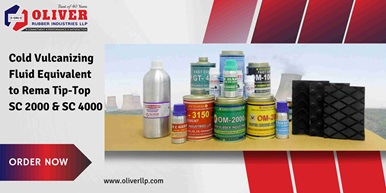Rubber Pulley Lagging Sheet: Enhancing Efficiency with Oliver Rubber LLP

At Oliver Rubber LLP, we take pride in being one of the foremost manufacturers of high-quality rubber sheets in India. With our commitment to excellence and innovation, we have established ourselves as a trusted name in the industry. Our extensive range of rubber sheets caters to diverse applications across various sectors, including automotive, construction, industrial, and more. Among our standout products is the Rubber Pulley Lagging Sheet, designed to optimize performance and durability in conveyor systems and industrial applications.
At Oliver Rubber LLP, we understand that every customer has unique requirements. That’s why we offer customizable solutions to tailor our Rubber Pulley Lagging Sheet according to your specific dimensions, thickness, hardness, and other parameters. In this blog post, we’ll dive deep into the world of Pulley Lagging, exploring its types, installation methods, materials, and costs, with a focus on how our products stand out in the market.
What is a Lagging Pulley?
A lagging pulley is a critical component in conveyor systems, designed to enhance the friction between the pulley and the conveyor belt. This increased grip prevents belt slippage, reduces wear and tear, and improves overall efficiency. Pulley Lagging typically involves applying a protective layer—often rubber—to the pulley surface. At Oliver Rubber LLP, our Rubber Pulley Lagging Sheet is engineered to provide superior traction, durability, and resistance to harsh environmental conditions.
What Thickness is a Pulley Lagging?
The thickness of Pulley Lagging depends on the application and operational demands. Standard thicknesses range from 6 mm to 20 mm, though custom options are available. For light-duty applications, a thinner lagging (6-10 mm) may suffice, while heavy-duty industrial conveyors might require thicker lagging (12-20 mm) for added durability. At Oliver Rubber LLP, we customize the thickness of our Rubber Pulley Lagging Sheet to match your specific needs, ensuring optimal performance and longevity.
How to Install Lagging on a Pulley?
Installing Pulley Lagging is a straightforward process when using high-quality materials like our Rubber Pulley Lagging Sheet. Here’s a basic guide:
- Preparation: Clean the pulley surface thoroughly to remove dirt, grease, or rust.
- Measurement and Cutting: Measure the pulley dimensions and cut the lagging sheet to fit precisely.
- Adhesive Application: Apply a strong adhesive (or use pre-glued sheets) to bond the lagging to the pulley.
- Pressing and Curing: Press the lagging firmly onto the pulley and allow it to cure as per the adhesive’s instructions.
- Inspection: Check for air bubbles or uneven application and make adjustments as needed.
Our team at Oliver Rubber LLP provides detailed support to ensure seamless installation.
Pulley Lagging in Conveyor Belt
In conveyor belt systems, Pulley Lagging plays a vital role in maintaining smooth operations. It prevents belt slippage, especially in wet or dusty conditions, and extends the lifespan of both the pulley and the belt. Our Rubber Pulley Lagging Sheet is specifically designed for conveyor belts, offering excellent abrasion resistance and flexibility.
Types of Pulley Lagging
There are several types of Pulley Lagging to suit different applications:
- Rubber Lagging: The most common type, offering high friction and durability (e.g., our Rubber Pulley Lagging Sheet).
- Ceramic Lagging: Embedded with ceramic tiles for extreme conditions.
- Polyurethane Lagging: Lightweight and resistant to chemicals.
- Diamond Groove Lagging: Features a patterned surface for enhanced grip.
At Oliver Rubber LLP, we specialize in rubber-based lagging, customizable to your needs.
Pulley Lagging Material
The choice of Pulley Lagging material impacts performance. Rubber is the preferred material due to its elasticity, abrasion resistance, and cost-effectiveness. Our Rubber Pulley Lagging Sheet is crafted from premium-grade rubber, ensuring it withstands heavy loads, moisture, and temperature fluctuations. Other materials like ceramic or polyurethane may be used for niche applications, but rubber remains the industry standard.
Pulley Lagging Cost
The cost of Pulley Lagging varies based on material, thickness, and customization. A standard Rubber Pulley Lagging Sheet from Oliver Rubber LLP is competitively priced, offering excellent value for money. Factors like installation method (glue-on vs. weld-on) and pulley size also influence the overall cost. Contact us for a tailored quote that fits your budget and requirements.
Glue on Pulley Lagging
Glue-on Pulley Lagging is a popular installation method due to its simplicity and effectiveness. Our Rubber Pulley Lagging Sheet is available with pre-applied adhesive options, making it easy to bond to the pulley surface. This method ensures a secure fit without the need for specialized equipment, reducing downtime during installation.
Conveyor Pulley Lagging
Conveyor Pulley Lagging is essential for industries relying on conveyor systems, such as mining, manufacturing, and logistics. By applying our Rubber Pulley Lagging Sheet, you can minimize belt slippage, reduce maintenance costs, and enhance productivity. Our lagging is designed to handle the toughest conditions, ensuring your conveyor system runs smoothly.
Weld-on Pulley Lagging
Weld-on Pulley Lagging involves attaching metal-backed rubber strips to the pulley using welding techniques. While this method offers a permanent solution, it requires more expertise and equipment compared to glue-on lagging. At Oliver Rubber LLP, we focus on versatile, easy-to-install rubber lagging, though we can provide guidance for weld-on applications if needed.
Conveyor Lagging
Conveyor Lagging refers to the broader application of lagging across conveyor system pulleys, including drive, tail, and take-up pulleys. Our Rubber Pulley Lagging Sheet is a versatile solution that meets the demands of various conveyor setups. Whether you need to improve traction or protect your equipment, our products deliver consistent results.
Why Choose Oliver Rubber LLP?
When it comes to Pulley Lagging, Oliver Rubber LLP stands out for its quality, customization, and customer-centric approach. Our Rubber Pulley Lagging Sheet is a testament to our dedication to innovation and performance. With years of experience in manufacturing rubber sheets, we’ve fine-tuned our processes to deliver products that exceed industry standards. Whether you’re in automotive, construction, or industrial sectors, our lagging solutions are designed to enhance efficiency and durability.
Ready to upgrade your conveyor system with the best Pulley Lagging? Contact Oliver Rubber LLP today to discuss your requirements and discover how our Rubber Pulley Lagging Sheet can make a difference.






